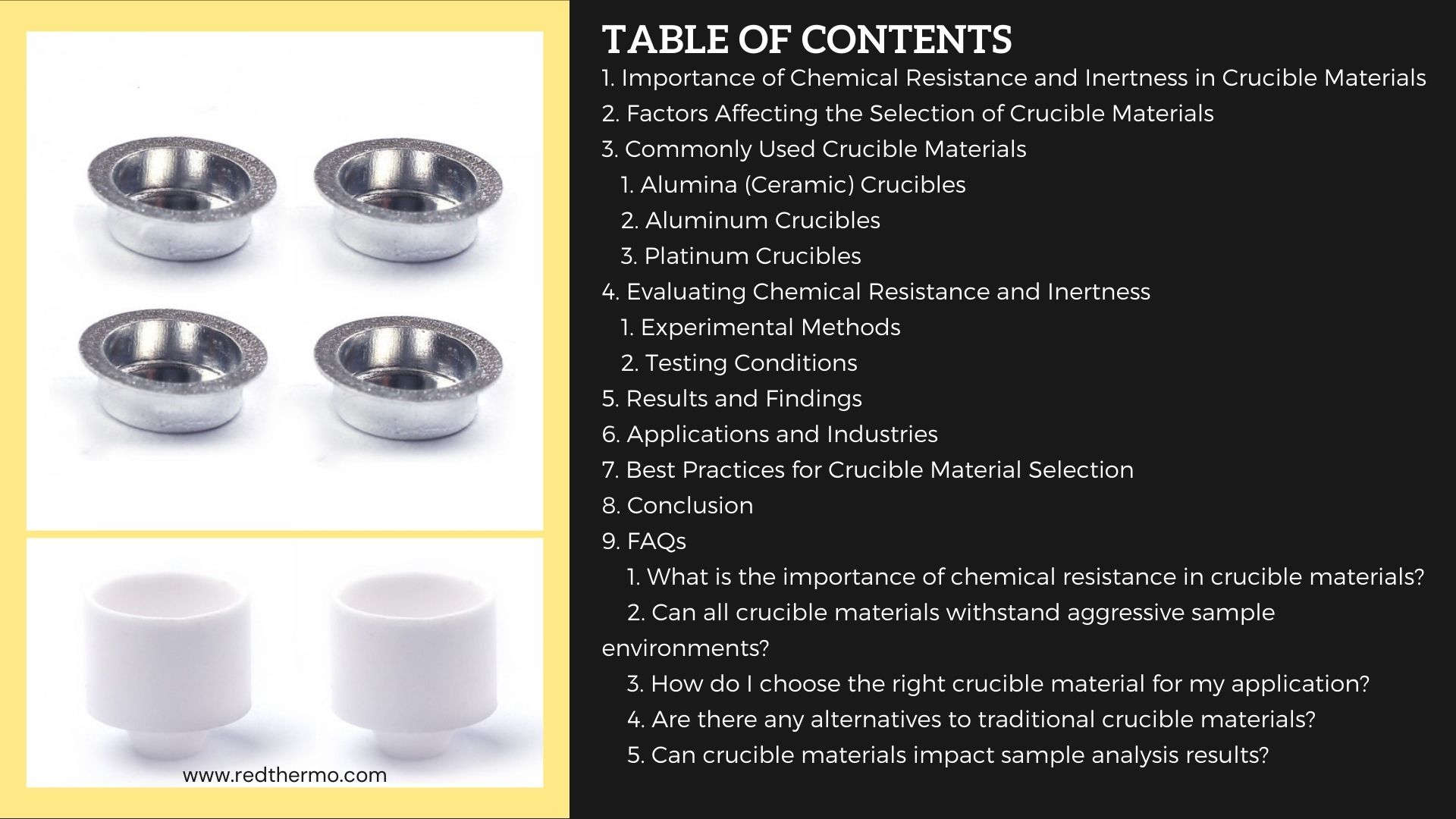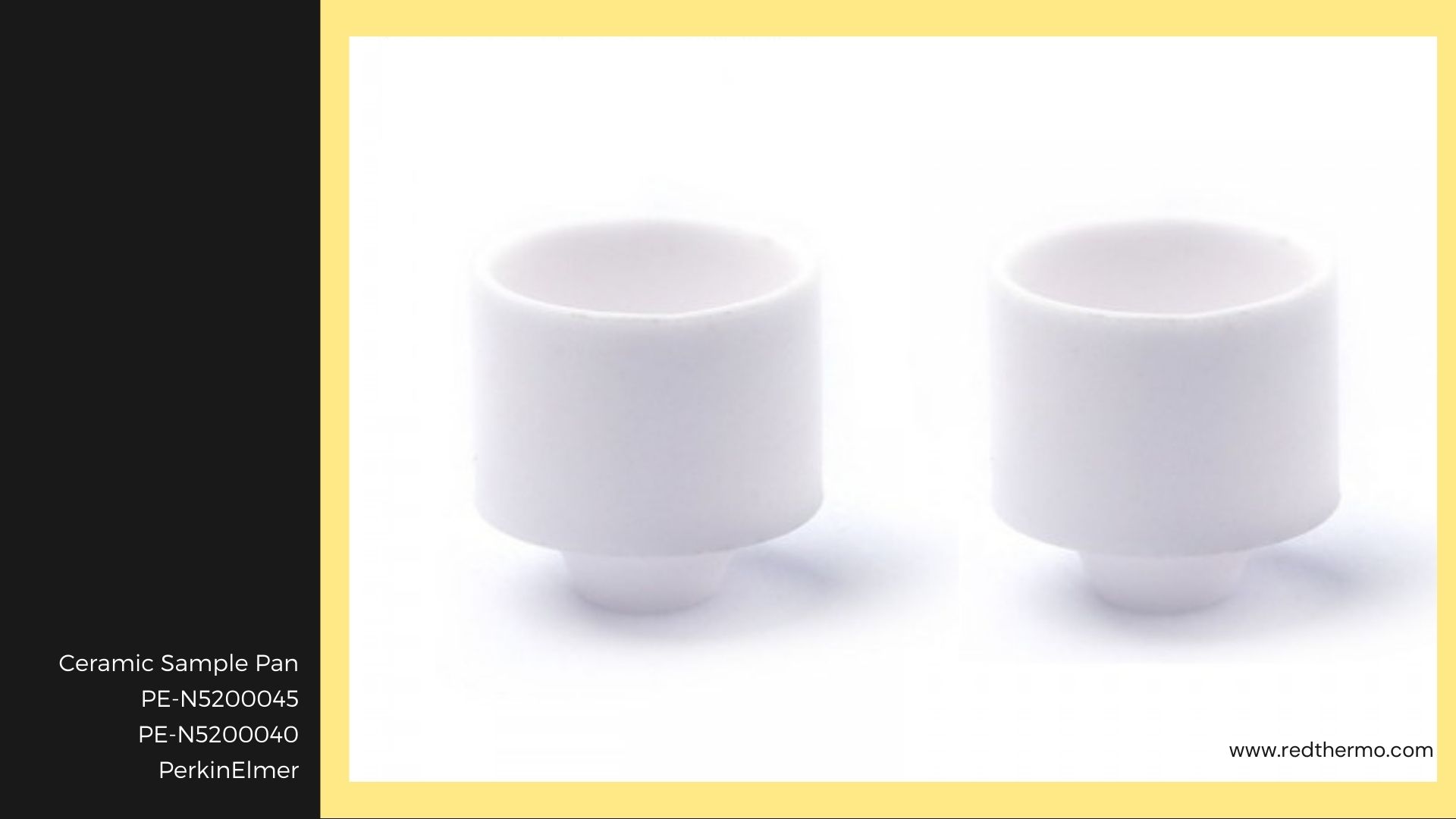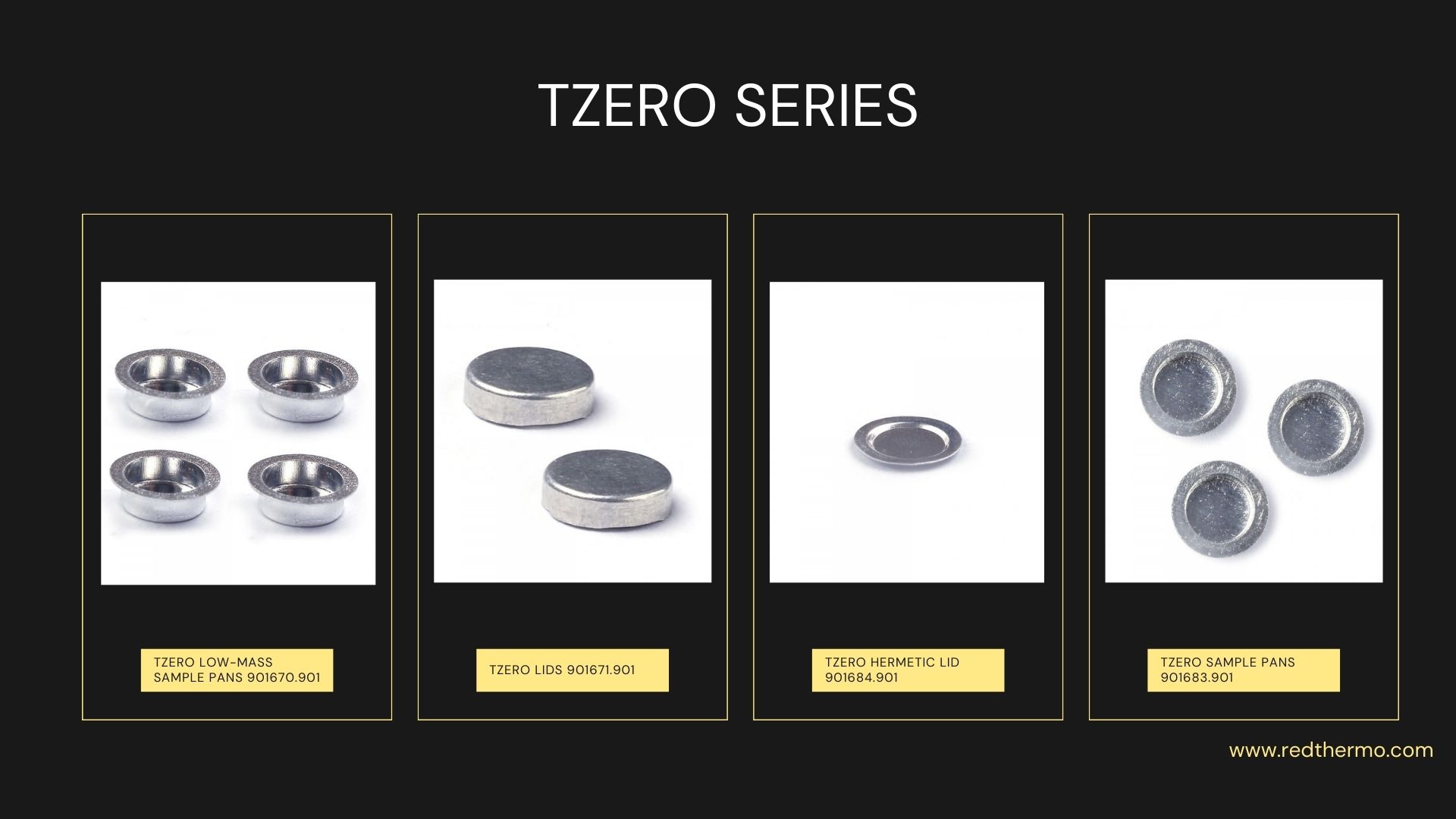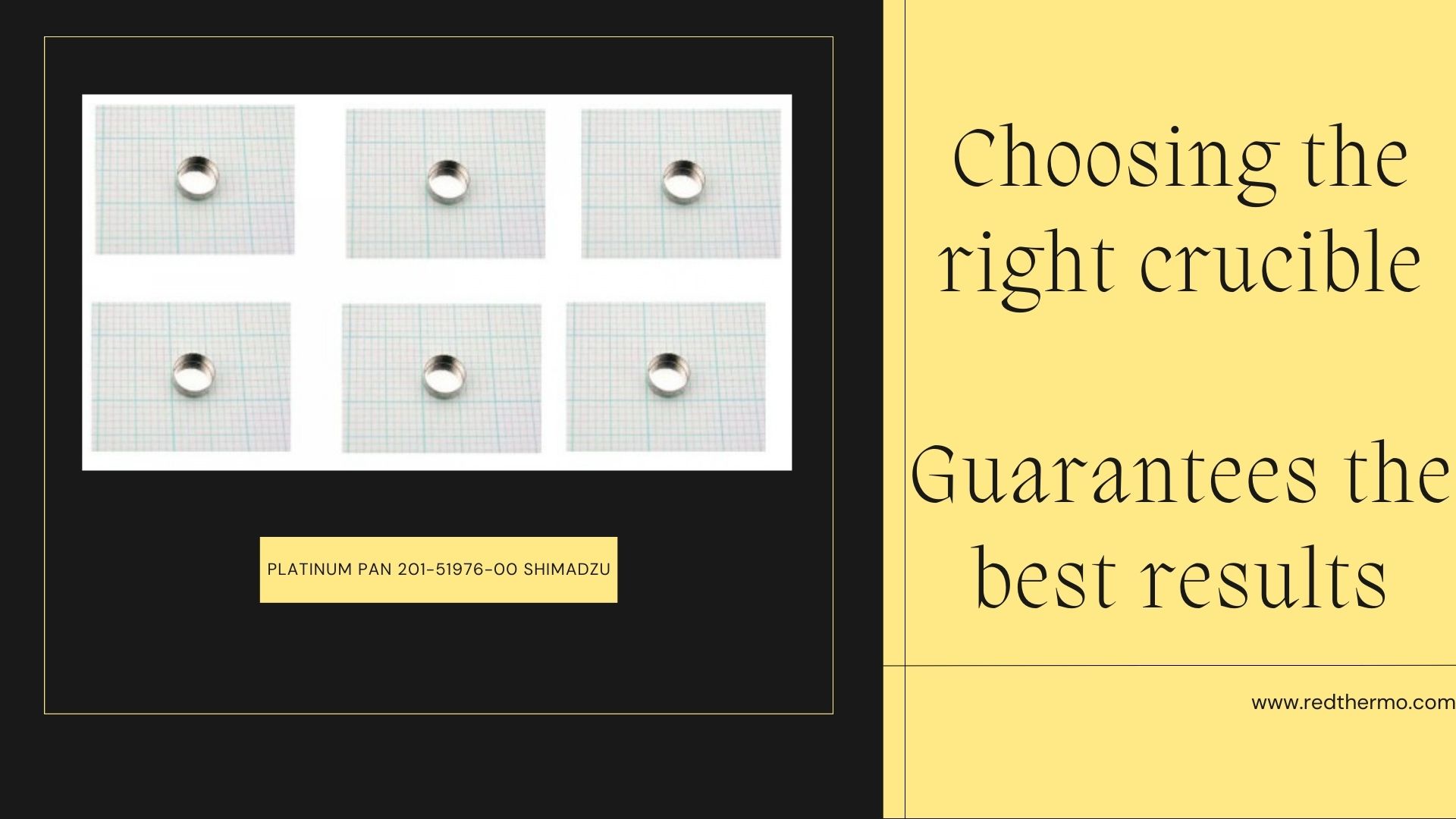Your cart is empty.
shop now
Your cart is empty.
shop now

1. Importance of Chemical Resistance and Inertness in Crucible Materials
2. Factors Affecting the Selection of Crucible Materials
3. Commonly Used Crucible Materials
1. Alumina (Ceramic) Crucibles
2. Aluminum Crucibles
3. Platinum Crucibles
4. Evaluating Chemical Resistance and Inertness
1. Experimental Methods
2. Testing Conditions
5. Results and Findings
6. Applications and Industries
7. Best Practices for Crucible Material Selection
8. Conclusion
9. FAQs
1. What is the importance of chemical resistance in crucible materials?
2. Can all crucible materials withstand aggressive sample environments?
3. How do I choose the right crucible material for my application?
4. Are there any alternatives to traditional crucible materials?
5. Can crucible materials impact sample analysis results?
Chemical resistance and inertness are critical characteristics of crucible materials, especially when dealing with aggressive sample environments. The resistance to chemical reactions ensures that the crucible remains stable and does not interact with the sample, thus preventing contamination or undesired chemical reactions. The inertness of crucible materials ensures that they do not introduce any impurities or alter the composition of the sample, enabling accurate and reliable results in analytical processes.
Several factors need to be considered when selecting crucible materials for aggressive sample environments. These factors include:
1. Temperature resistance: Crucibles should be able to withstand high temperatures without melting or undergoing structural changes.
2. Chemical compatibility: Crucible materials should be compatible with the chemicals and substances present in the sample, ensuring no adverse reactions or contamination.
3. Thermal shock resistance: Crucibles should have good thermal shock resistance to withstand rapid temperature changes without cracking or breaking.
4. Mechanical strength: Crucible materials should possess sufficient mechanical strength to withstand handling, stirring, and pouring processes.
5. Sample volume: The size and volume of the sample may influence the choice of crucible material to ensure proper containment and handling.
There are several crucible materials available, but the most commonly used ones for aggressive sample environments include alumina (ceramic), aluminum, and platinum crucibles.
Alumina crucibles, made from aluminum oxide (Al2O3), are widely used due to their excellent chemical resistance and high-temperature stability. They can withstand aggressive acids, alkalis, and molten metals, making them suitable for various applications in laboratories and industries. Alumina crucibles are particularly favored for their affordability and durability.

Ceramic Sample Pans PE-N5200045 PE-N5200040 PerkinElmer
Aluminum crucibles are preferred for their lightweight nature and high thermal conductivity. They exhibit good chemical resistance to non-acidic substances and are often used for melting and casting processes. However, aluminum crucibles may not be suitable for aggressive acidic or alkaline environments, as they can react with these chemicals.

Platinum crucibles are known for their exceptional chemical inertness, making them highly suitable for aggressive sample environments. They exhibit resistance to a wide range of chemicals, including acids, alkalis, and molten metals. Platinum crucibles are commonly used in high-precision analytical processes and research applications. However, they are more expensive compared to other crucible materials.

Platinum pan 201-51976-00 Shimadzu
To assess the chemical resistance and inertness of crucible materials in aggressive sample environments, various experimental methods are employed. These methods involve subjecting the crucibles to specific conditions and analyzing their performance. The evaluation process may include:
1. Immersion tests: Immersing the crucible in aggressive chemicals for a specified duration to observe any changes or reactions.
2. Heating tests: Subjecting the crucible to elevated temperatures to determine its stability and resistance to thermal stress.
3. Corrosion tests: Exposing the crucible to corrosive substances and assessing any signs of corrosion or degradation.
4. Compatibility tests: Testing the crucible with different types of samples to evaluate its inertness and any potential interactions.
The evaluation of crucible materials involves replicating the specific aggressive sample environment to simulate real-life conditions accurately. Factors such as temperature, chemical concentration, exposure duration, and mechanical stress are carefully controlled to obtain reliable results.
The evaluation of crucible materials in aggressive sample environments provides valuable insights into their performance and suitability for various applications. Based on the experimental tests, researchers and users can determine the most appropriate crucible material for their specific needs. The results may highlight the chemical resistance, inertness, temperature limits, and limitations of different crucible materials.
The choice of crucible material depends on the specific application and industry requirements. Alumina (ceramic) crucibles find applications in laboratories, research facilities, and industrial processes involving aggressive chemicals. Aluminum crucibles are commonly used in foundries and metal casting operations. Platinum crucibles are indispensable in high-precision analytical processes, such as spectroscopy and trace element analysis.
When selecting a crucible material for aggressive sample environments, it is essential to consider the specific requirements of the application. Some best practices include:
1. Understand the sample: Determine the chemical composition and behavior of the sample to identify potential reactivity with different crucible materials.
2. Assess temperature requirements: Consider the temperature range and thermal stability required for the application to select a suitable crucible material.
3. Consult expert advice: Seek guidance from experienced professionals or suppliers who can provide insights into the best crucible material for your specific needs.
4. Consider cost-effectiveness: Balance the performance requirements with the cost of the crucible material, ensuring optimal value for the application.
5. Regular maintenance and inspection: Periodically inspect and maintain crucibles to ensure their longevity and performance.
In aggressive sample environments, the chemical resistance and inertness of crucible materials are crucial factors to consider. The choice of crucible material directly impacts the reliability and accuracy of analytical results. Alumina (ceramic), aluminum, and platinum crucibles are commonly used materials, each with its own set of advantages and limitations. By evaluating crucible materials through appropriate experimental methods and considering the specific requirements of the application, researchers and users can make informed decisions when selecting the most suitable crucible material for their needs.
Chemical resistance is essential in crucible materials to prevent contamination and undesired reactions with the sample, ensuring accurate and reliable results in analytical processes.
Not all crucible materials can withstand aggressive sample environments. Crucible materials such as alumina (ceramic), aluminum, and platinum are specifically chosen for their chemical resistance and inertness.
To choose the right crucible material, consider factors such as temperature resistance, chemical compatibility, thermal shock resistance, mechanical strength, and sample volume. Consulting with experts can provide valuable guidance.
There are alternative crucible materials available, depending on the specific application. However, alumina (ceramic), aluminum, and platinum remain the most commonly used crucible materials for aggressive sample environments.
Yes, crucible materials can impact sample analysis results. The choice of crucible material affects the chemical interactions and potential contamination, which can influence the accuracy and reliability of analytical results.